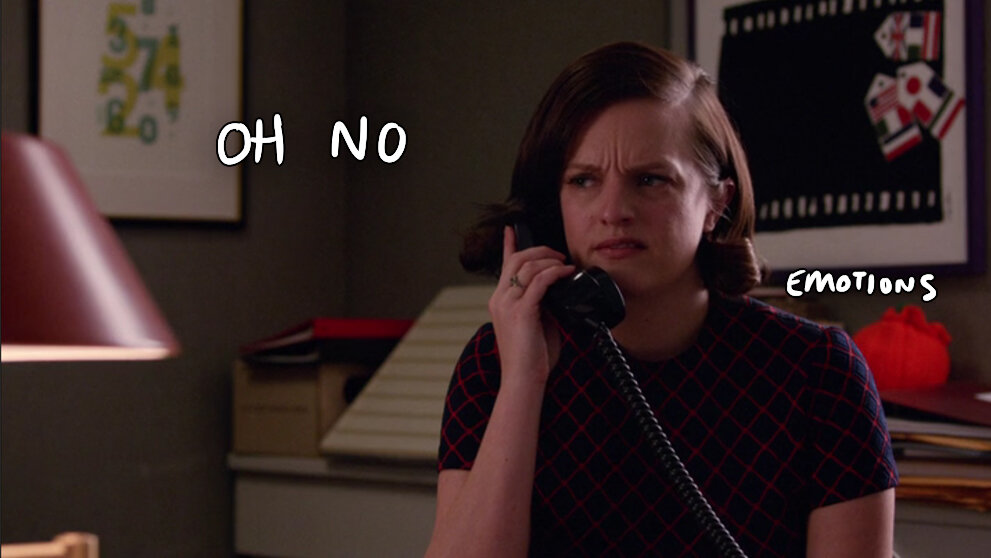Cognitive Bias In The Business Of Advertising: Types of Bias
This is Part Two of our Cognitive Bias in Advertising series. Read Parts One, Three, and Four.
To begin with, I’ll work through a limited set of scientifically catalogued cognitive biases, but if you want to explore the subject more deeply, this is not a terrible place to start: https://en.wikipedia.org/wiki/List_of_cognitive_biases
Availability
Source: The ever delightful Mad Men Screenshots With Things Drawn On Them
“Availability” describes the ease with which an idea can be brought to mind, or the act of a human estimating how likely or frequent an event is. People tend to overestimate the likelihood of dramatic, vivid events, like terrorism or tornadoes, because they have become familiar with the concepts through vivid stories in cultural transmission or, more specifically, mass media.
Highly publicized events have a higher “availability” to the average person because vivid stories are more powerful in linking causal relationships or in estimating risk than statistically true but relatively mundane facts. This is why people are more scared of dying in terrorist attacks or plane crashes than they are of dying from diabetes or falling off a ladder at home, even though the latter examples are far more statistically likely to occur.
People falsely believe that a vivid, dramatic, wildly unlikely thing is more likely to happen to them because it is easier for them to imagine. They can picture it happening to them and they imagine they know the precise and certain outcome. The fact that these dramatic, vivid stories are easy to remember also tends to make people automatically think they are more important, and this strengthens the perception of causality where correlation may not even exist.
Kahnemann and Tversky attributed the occurrence of availability to three primary factors: frequency of repetition, frequency of co-occurrence, and illusory correlation. If you think about those three factors the path to mistakes in judgment due to availability becomes obvious.
The more often someone hears or encounters an idea, the easier it is for that someone to recall relevant examples in great detail;
The more often these stores are told as examples of the original idea, the more they occur together within this circumstance (i.e. being included together within a list or category), which tends to make our original someone think these things are occurring together in general;
These two elements reinforce each other until a relationship is perceived in the mind of our special someone.
This is how stereotypes are born. This is, at root, the source of every insane email forward you've ever received from a family member. It is how people use paid media to perpetuate half-baked conspiracy theories and meddle in elections in a foreign country.
Anchoring and Adjustment
This describes the phenomenon of a person starting from an ANCHOR – a readily available number – and seeking plausibility from there, based on that anchoring number. People will hew to the starting point they are given and treat it as a mean. The headline about this kind of bias is that anchor values contaminate estimations and destroy a person’s ability to be objective.
The easiest and most common example of this within our business is when someone says something like, “How many clicks will I get for $1,000?” It is not possible for you to give them a number that will in any way reflect objective reality or a functional context, but whatever you tell them will be the number against which any future outcome is judged.
And, to drive this point home, any random number considered prior to judgment of numeric or perceived values will contaminate the estimation. Literally, if people write down the last two numbers of their social security numbers, and they KNOW they are writing down the last two numbers of their social security number, the act of them thinking of those numbers and then being asked if they would be willing to pay that number for some luxury good has an immediate and demonstrable effect on a closely followed activity, like bidding in a blind auction for the kind of item you were just discussing.
Affect Heuristic
The affect heuristic describes how fear, pleasure, surprise, or sadness in response to a stimulus affects someone’s ability to make sense of information. When people use gut reactions to judge benefits or risks, it makes emotionally framed messages more persuasive.
If you’ve ever wondered why negative political ads are so scary, this is why — those ads are meant to persuade a persuadable audience that is on the fence about an issue or candidate. And if they don’t work on you or immediately turn you off, it is because you are not persuadable, and thus aren’t in a pre-required state of consideration about the subject.
Sometimes the people that make these ads turn into this skid and go way deep on the fear, thinking this can work higher up the chain, and convert non-persuadable voters into persuadable voters. This obviously and unfortunately works, especially when fear affect is paired with high repetition stories thrown together in an imagined, dramatic context. Whether it results in a conspiracy theory or a totally false meme, these stories persist. They persist because they are designed to persist, and humans have evolved, brain-wise, to accept these. In terms of our ability to make good, logical decisions, this is a crippling vulnerability.
Next — more types of bias, namely: Representativeness.


